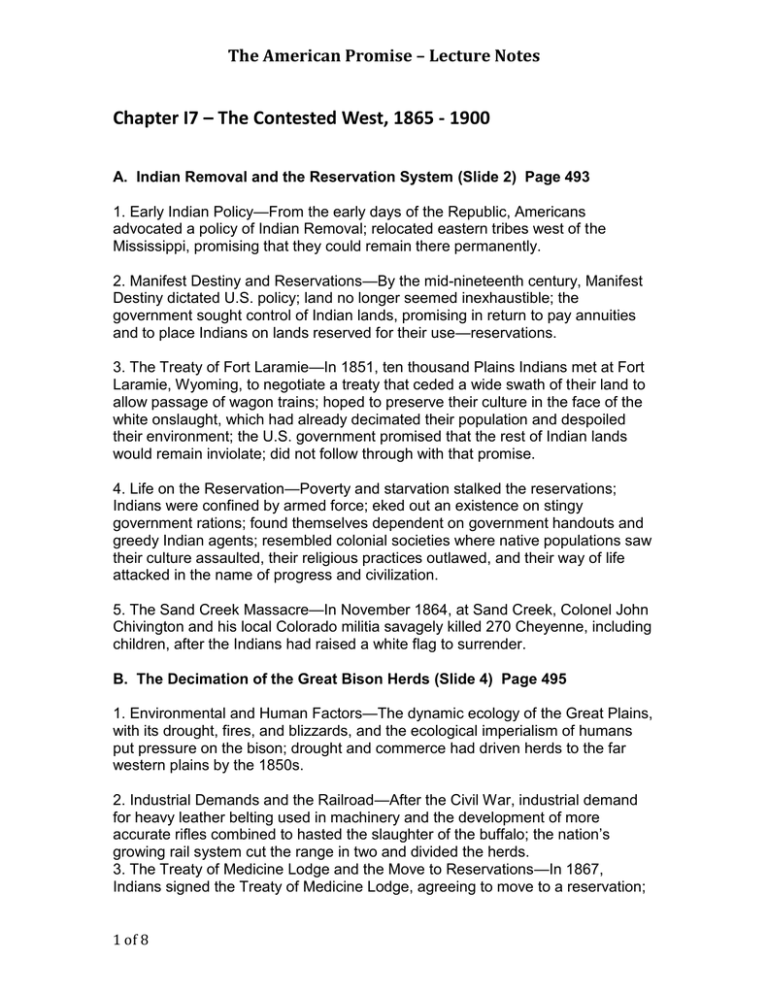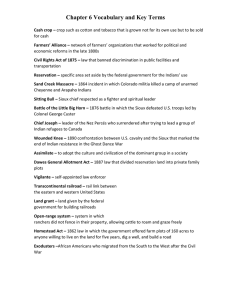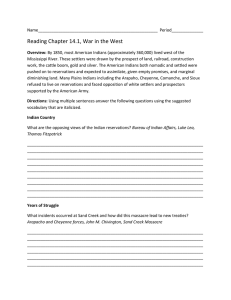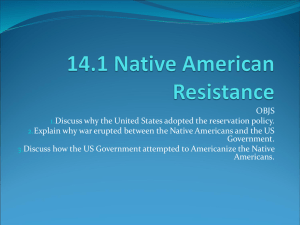Class Lecture Notes 17.doc
advertisement

The American Promise – Lecture Notes Chapter I7 – The Contested West, 1865 - 1900 A. Indian Removal and the Reservation System (Slide 2) Page 493 1. Early Indian Policy—From the early days of the Republic, Americans advocated a policy of Indian Removal; relocated eastern tribes west of the Mississippi, promising that they could remain there permanently. 2. Manifest Destiny and Reservations—By the mid-nineteenth century, Manifest Destiny dictated U.S. policy; land no longer seemed inexhaustible; the government sought control of Indian lands, promising in return to pay annuities and to place Indians on lands reserved for their use—reservations. 3. The Treaty of Fort Laramie—In 1851, ten thousand Plains Indians met at Fort Laramie, Wyoming, to negotiate a treaty that ceded a wide swath of their land to allow passage of wagon trains; hoped to preserve their culture in the face of the white onslaught, which had already decimated their population and despoiled their environment; the U.S. government promised that the rest of Indian lands would remain inviolate; did not follow through with that promise. 4. Life on the Reservation—Poverty and starvation stalked the reservations; Indians were confined by armed force; eked out an existence on stingy government rations; found themselves dependent on government handouts and greedy Indian agents; resembled colonial societies where native populations saw their culture assaulted, their religious practices outlawed, and their way of life attacked in the name of progress and civilization. 5. The Sand Creek Massacre—In November 1864, at Sand Creek, Colonel John Chivington and his local Colorado militia savagely killed 270 Cheyenne, including children, after the Indians had raised a white flag to surrender. B. The Decimation of the Great Bison Herds (Slide 4) Page 495 1. Environmental and Human Factors—The dynamic ecology of the Great Plains, with its drought, fires, and blizzards, and the ecological imperialism of humans put pressure on the bison; drought and commerce had driven herds to the far western plains by the 1850s. 2. Industrial Demands and the Railroad—After the Civil War, industrial demand for heavy leather belting used in machinery and the development of more accurate rifles combined to hasted the slaughter of the buffalo; the nation’s growing rail system cut the range in two and divided the herds. 3. The Treaty of Medicine Lodge and the Move to Reservations—In 1867, Indians signed the Treaty of Medicine Lodge, agreeing to move to a reservation; 1 of 8 The American Promise – Lecture Notes but they continued to hunt during the summer months; after 1850, hide hunters poured into the region and within a decade they had nearly exterminated the southern bison herds; with the buffalo gone, the Indians faced starvation and reluctantly moved to reservations. C. Indian Wars and the Collapse of Comanchería 1. The Last Resistance in the West and the Great Sioux Uprising—Indian wars against white settlers in the West marked the last resistance of a Native American population devastated by disease and demoralized by the Indian removal policy; in 1862, the starving Dakota Sioux in Minnesota went to war; under Chief Little Crow, the Sioux killed more than 1,000 white settlers before American troops quelled the uprising; 400 Indians were put on trial for murder and 38 died in the largest mass execution in American history. 2. Grant’s “Peace Policy”—President Grant wanted to avoid the money and sacrifice in lives that would result from protracted Indian wars; adopted a “peace policy” designed to segregate and control Indians while opening up the land to white settlers; General William Tecumseh Sherman summed up the policy: “Remove all to a safe place and then reduce them to a helpless condition.” 3. The End of Comanchería—In 1871, Grant’s peace policy gave way to all-out warfare as the U.S. Army dispatched three thousand soldiers to wipe out the remains of the Comanche empire; the army’s scorched-earth policy, combined with the decimation of the bison, led to the final collapse of the Comanche people; the only survivors—1,500 Comanche—retreated to the reservation at Fort Sill. D. The Fight for the Black Hills (Slide 6) Page 497 1. The Second Treaty of Fort Laramie—Cheyenne and Sioux united in 1866 to protect their hunting grounds in the Powder River Valley; their efforts led the United States to negotiate the second Treaty of Fort Laramie in 1868, which guaranteed Indians control of their sacred land in the Black Hills; several Sioux chiefs, including Crazy Horse and Sitting Bull, refused to sign the treaty. 2. The Discovery of Gold and Battling for the Black Hills—Discovery of gold in the Black Hills of the Dakotas led the federal government to break its promise to preserve that land as sacred to the Indians; miners and the Northern Pacific Railroad invaded the region; at first, the government offered to purchase the Black Hills, but the Sioux believed the land sacred and refused to sell; the army responded by ordering all Lakota Sioux and Northern Cheyenne Indians onto the Pine Ridge Reservation and threatened to hunt down those who refused. 3. The Battle of Little Big Horn—Under the leadership of Crazy Horse and Sitting Bull, the Sioux tribes mounted resistance, winning a pyrrhic victory against Lieutenant Colonel George Custer at the Battle of Little Big Horn in 1876; in the 2 of 8 The American Promise – Lecture Notes five years that followed, Crazy Horse was killed, Sitting Bull surrendered, and the government had taken the Black Hills, confining the Lakota to the Great Sioux reservation; the Sioux never accepted the loss of the Black Hills, filing suit and demanding compensation for lands illegally taken from them; in 1980, the Supreme Court granted $122.5 million in monetary compensation to the tribes, but the Sioux refused the settlement and continue to press for the return of the Black Hills. II. Forced Assimilation and Resistance Strategies A. Indian Schools and the War against Indian Culture (Slide 8) Page 499 1. Cultural Battleground: Indian Education—Purpose of the Indian schools: “to destroy the Indian in him and save the man”; in 1877, Congress appropriated funds for Indian education because “it was less expensive to educate Indians than to kill them”; authorities preferred boarding schools in order to isolate students from tribal values. 2. Indian Resistance—Many Native American parents resisted sending their children away; when all else failed, the military kidnapped the children and sent them off to school. 3. Assimilation—Once at the school, children’s clothing and belongings were confiscated; hair cut off; issued uniforms; received Anglo-American names; curriculum featured agricultural and manual arts for boys and domestic skills for girls; students sent to live with white families during vacations; sought to instill the values of capitalism. B. The Dawes Act and Indian Land Allotment 1. Farming and Property Ownership—In the 1880s, the practice of relocating the Indians onto reservations lost momentum in favor of allotment—a new policy designed to encourage assimilation through farming and the ownership of private property. 2. Criticism of Reservations—People sympathetic to the Indians were appalled by the poverty on reservations; Helen Hunt Jackson in A Century of Dishonor (1881) argued Indians had been treated unfairly; the Indian Rights Association campaigned for the dismantling of reservations. 3. Reducing Land and Destroying Culture—Passed in 1887; abolished reservations and allotted lands to individual Indians as private property; Indian rights groups viewed the Dawes Act as a positive initiative, but the act effectively reduced Indian lands from 138 million acres to a scant 48 million; dealt a crippling blow to traditional tribal culture. 3 of 8 The American Promise – Lecture Notes C. Indian Resistance and Survival (Slide 9) Page 500 1. Varied Responses to U.S. Reservation Policy—Faced with the extinction of their traditional ways of life, different groups of Indians responded in different ways in the waning decades of the nineteenth century; the Crow, Arikara, Pawnee, and Shoshoni fought alongside the U.S. Army against their old enemies, the Sioux, in an effort to hold onto their lands. 2. The Flight of the Nez Percé—Indians who refused to stay on reservations risked being hunted down; in 1877, the army ordered the Nez Percé to come in to the reservation or be hunted down; the Nez Percé fled to Canada to escape confinement; stopped to rest after 1,300 miles, only 50 miles from freedom; American soldiers attacked; the Nez Percé surrendered to U.S. Army soldiers after a five-day siege. 3. Apache Armed Resistance—Apache tribes resorted to armed resistance and perfected a hit-and-run guerrilla warfare that terrorized white settlers and bedeviled the army in the 1870s and 1880s; Geronimo repeatedly led Apache warrior raiding parties off the reservation; eventually surrendered to General Nelson Miles in 1886; government arrested nearly five hundred Apaches, though fewer than three dozen had been hostile, and sent them as prisoners to Florida, where more than a quarter of them died; in 1892, the Apaches were moved to Fort Sill in Oklahoma and then later to New Mexico. 4. The Ghost Dance—On the plains, many tribes turned to a nonviolent form of resistance—the new Ghost Dance religion, founded in 1889; Paiute shaman Wovoka prophesied that if all Indians would unite in the Ghost Dance ritual, whites would be destroyed in an apocalypse; religion spread like wildfire. 5. Wounded Knee—The Ghost Dance was generally nonviolent, but whites feared an uprising, prompting President Benjamin Harrison to dispatch several thousand federal troops to Sioux country to handle any outbreak; in December 1890, when Sitting Bull joined the Ghost Dance in South Dakota, he was shot and killed by Indian police as they tried to arrest him at his cabin on the Standing Rock Reservation. The fleeing Sioux were apprehended at Wounded Knee Creek and a melee ensued; the army opened fire on the Indians; minutes later, more than two hundred Sioux lay dead or dying in the snow; the subjugation of the American Indians marked the first chapter in a national mission of empire that would later lead to overseas imperialistic adventures. III. Gold Fever and the Mining West 4 of 8 The American Promise – Lecture Notes A. Mining on the Comstock Lode (Slide 12) Page 504 1. Silver in Nevada—In 1859, refugees from California’s goldfields flocked to the Washoe basin in Nevada, where they found the richest silver ore on the continent—the legendary Comstock Lode. 2. Financing Silver Mining—Silver mining was an expensive operation that required capital and technological resources to exploit the claims; an active San Francisco stock market sprang up to finance operations on the Comstock; speculation, misrepresentation, and outright thievery ran rampant. 3. The Immigrant Population in the Cosmopolitan West—The promise of gold and silver drew thousands of men to the mines of the West, the honest as well as the unprincipled; also drew an array of immigrants, making Virginia City more cosmopolitan than either New York or Boston; Irish immigrants formed the largest ethnic group in the mining district; Irish and Irish American women constituted the largest group of women on the Comstock; conversely, the Chinese community was overwhelmingly male; subject to anti-Chinese discrimination. 4. Another Clash between Euro-Americans and Native Americans—Discovery of precious metals spelled disaster for the Indians; miners demanded army troops “hunt Indians” and establish forts; natives became exiles in their own land; developed resourceful strategies to adapt and preserve their culture and identity. 5. Corporate Comstock—In 1873, Comstock miners uncovered a new vein of ore, prompting the transition from small-scale industry to corporate enterprise. 6. New Technology, New Dangers—New technology eliminated some of the dangers of mining but not all; in the 1870s, one out of thirty miners was injured on the job and one out of eighty killed; although the mining towns of the Wild West were often depicted as lawless outposts, these places were often urbanized and industrialized; by 1875, Virginia City boasted a population of 25,000 people, making it one of the largest cities between St. Louis and San Francisco. B. The Diverse Peoples of the West (Slide 14) Page 506 1. African Americans—Faced hostile settlers determined to keep the West “for whites only”; formed all-black communities such as Nicodemas, Kansas; up to 25,000 black soldiers served in the Indian wars; called buffalo soldiers because Indians thought their hair resembled that of a bison; boasted the lowest desertion rate in the army. 2. Hispanic Peoples—Had lived in Texas and the Southwest since 1598 and the Pacific coast since 1769; many Californios ended up segregated in urban barrios 5 of 8 The American Promise – Lecture Notes in their own homeland; their percentage of California’s population declined from 82 percent in 1850 to 19 percent in 1880; in New Mexico and Texas, Mexicans remained a majority of the population but became increasingly impoverished as Anglos dominated business and took the best jobs. 3. The Chinese—Suffered the most brutal treatment at the hands of employers and other laborers; more than 20,000 had come to California by 1852; miners succeeded in passing license laws to keep the Chinese out of the mines; found work when white workers moved to find riches in Nevada; some 12,000 completed America’s first transcontinental railroad. 4. Chinese Exclusion—Chinese and other Asians continued to be denied access to citizenship; in the 1870s when California and the rest of the nation fell into depression, the Chinese became easy scapegoats; in 1876, the Workingmen’s Party formed to fight for Chinese exclusion; Congress passed the Chinese Exclusion Act in 1882, effectively barring Chinese immigration; Chinese population dropped from 105,465 in 1880 to 89,863 in 1900 because Chinese immigrants did not have families to sustain their population. 5. Mormons—Established Salt Lake City in 1882; to counter criticism of polygamy, the Utah territorial legislature gave women the right to vote in 1870, the first universal suffrage act in the nation; church hierarchy did not renounce polygamy until 1890, and the controversy postponed statehood for Utah until 1896. C. Territorial Government 1. Benign Neglect—The federal government practiced a policy of benign neglect toward territorial government in the West; president appointed a governor, a secretary, and two to four judges, along with an attorney and a marshal. 2. Territorial Governors—Nevada, because of its mines, became a state in 1864; but many areas remained territories for decades, during which time they were subject to territorial governors, who were underpaid and unqualified; often experienced long delays in receiving their salaries and often had to pay government expenses out of their own pockets; nearly all territorial appointees tried to make ends meet by maintaining business connections in the East or by investing in the West; territorial governments were rife with conflicts of interest and corruption, mirroring the political and economic values (or lack thereof) of the late nineteenth century IV. Land Fever A. Moving West: Homesteaders and Speculators (Slide 15) Page 510 6 of 8 The American Promise – Lecture Notes 1. Challenges—People who ventured west faced hardship, loneliness, and deprivation; even the best farmer could face blizzards, tornadoes, grasshoppers, hailstorms, drought, prairie fires, accidental death, and disease; even with free land, homesteaders still needed as much as $1,000 for a house, a team of farm animals, a well, fencing, and seed. 2. Women on the Frontier—For women on the frontier, simple daily tasks such as obtaining water and fuel meant backbreaking labor. 3. Success and Failure—Some homesteaders succeeded in building comfortable lives, but for others, the promise of the West failed to materialize; by the 1870s, much of the best land was taken; the least desirable tracts were left for homesteaders; the railroads were by far the biggest winners in the scramble for western land. 4. The Great American Desert—As land grew scarce on the prairie in the 1870s, farmers began to push farther west; moved into western Kansas, Nebraska, and eastern Colorado—an area known as the Great American Desert; farmers attempted to cultivate the region, but cyclical droughts in the 1880s and 1890s sent starving farmers reeling back from the plains. 5. Oklahoma Land Runs—The opening of two million acres of land in former Indian Territory in Oklahoma in 1889 brought as many as ten thousand settlers in one day. B. Ranchers and Cowboys 1. The Cattle Kingdom—Between 1865 and 1885, cattle ranchers followed the railroads onto the plains, establishing a cattle kingdom from Texas to Wyoming; barbed wire revolutionized the cattle business: As the largest ranchers in Texas began to build fences, nasty fights broke out with “fence cutters,” who resented the end of the free range; on the range, the cowboys (many of whom were African-American) gave way to the cattle king and, like the miner, the cowboy became a wage laborer. 2. The End of the Open Range—By 1886, cattle overcrowded the range, but severe blizzards during the winters of 1886–87 and 1887–88 decimated the herds; in the aftermath of the storms, new and more labor-intensive forms of cattle ranching replaced the open-range model. C. Tenants, Sharecroppers, and Migrants (Slide 20) Page 514 1. Exodusters—Few ex-slaves obtained land of their own in the South; some managed to pull together enough resources to go west, but most remained propertyless farm laborers. 7 of 8 The American Promise – Lecture Notes 2. Vaqueros—In California, skilled horsemen—Mexican cowboys called vaqueros—commanded decent wages until the 1870s, when the coming of the railroads ended the long cattle drives and the need for the vaqueros’ skills; forced them to become migrant laborers, often on land their families had once owned. 3. Tejanos—After the heyday of cattle ranching ended in the late 1880s, cotton production began its rise in southeastern Texas; ranch life soon gave way to a growing army of agricultural wageworkers. 4. Migratory Labor—Land monopoly and large-scale farming fostered tenancy and migratory labor; most farm laborers were Chinese immigrants; after the Chinese Exclusion Act of 1882, Mexicans, Filipinos, and Japanese immigrants filled the demand. D. Commercial Farming and Industrial Cowboys 1. Farming Revolution—In the late nineteenth century, America’s population remained overwhelmingly rural; new technology and farming techniques revolutionized American farm life; mechanized farm machinery halved the time and labor cost of production and made it possible to cultivate vast tracts of land; meanwhile, urbanization opened markets; railroads carried crops; American agriculture entered the era of agribusiness. 2. Volatile Markets—Like cotton farmers in the South, western grain and livestock farmers increasingly depended on foreign markets for their livelihood; a fall in global market prices meant that a farmer’s entire harvest went to pay off debts. 3. Western Industrialism—Commercial farming, along with mining, represented another way in which the West developed its own brand of industrialism; two Alsatian immigrants, Henry Miller and Charles Lux, pioneered the West’s mixture of agriculture and industrialism; developed investment strategies and corporate structures to control not only California land but water rights as well; the firm Miller & Lux shared the main characteristics of other modern enterprises: corporate consolidation, vertical integration, and schemes to minimize labor costs and stabilize the workforce. 4. The Transformation of the American Farmer—By the end of the nineteenth century, agriculture had been transformed; typical farmer was no longer a selfsufficient yeoman but was tied to global markets as either a businessman or a wage laborer. 8 of 8








